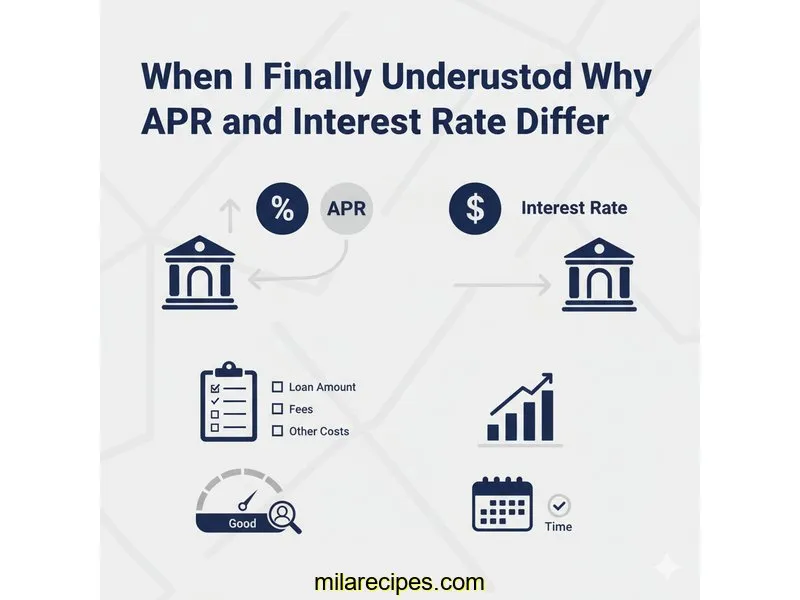
Auto Loan Calculator
Calculate payments over the life of your Loan
Home Blog Privacy Terms About Contact
Calculate payments over the life of your Loan
Home Blog Privacy Terms About ContactPublished on October 26, 2025

My journey into the world of loan calculations started with a simple, nagging question. I was looking at a sample loan breakdown online, just out of curiosity, and I saw two different percentages listed side-by-side. One was labeled "Interest Rate: 6.7%" and the other was "APR: 7.24%." My first thought was that it had to be a typo. How could the same loan have two different rates?
For a while, I just assumed "APR" was some kind of complicated financial term I didn't need to worry about. I figured the "interest rate" was the number that really mattered. But the more I looked at different examples, the more I saw this pattern. The APR was almost always slightly higher than the interest rate, and that gap between the two numbers seemed to change from one loan to the next. What was this hidden percentage? Why did it exist?
This wasn't about trying to find the best loan or make a financial decision. My goal was much simpler and, to me, more fundamental: I just wanted to understand the math. I wanted to know why 6.7% wasn't the whole story. What was happening behind the scenes to create that second, higher number? It felt like a puzzle, and I was determined to figure out how the pieces fit together. This is the story of that journey—a personal exploration of how the calculations work. Please remember, this is about understanding how calculations work, not financial advice.
I decided to open a spreadsheet and grab a calculator, thinking I could probably reverse-engineer the logic myself. I felt confident I could make the numbers match. As I would soon find out, my confidence was a bit misplaced, and my initial assumptions about how this math worked were completely wrong. That initial failure, however, is what ultimately led to my breakthrough.
My first step was to take a hypothetical loan and try to calculate everything manually. I created a scenario in my head: a loan for $13,850 with a term of 48 months and that stated interest rate of 6.7%. My logic seemed straightforward enough. I thought I could figure out the total cost by calculating the interest for the whole term and adding it to the principal.
My simple, and very wrong, calculation went something like this: I took the principal ($13,850) and multiplied it by the annual interest rate (0.067) to get the interest for one year, which was $927.95. Then I multiplied that by the term in years (4) to get a total interest of $3,711.80. This seemed plausible. So, my estimated total cost was $13,850 + $3,711.80 = $17,561.80.
Feeling pretty good about my math, I turned to a trusted online loan calculator to verify my work. I plugged in the same numbers: $13,850 loan amount, 6.7% interest rate, 48-month term. I hit "Calculate," and my confidence vanished. The calculator showed a monthly payment of around $331.32 and a total interest paid of $2,053.36. My manual calculation was off by more than $1,600! It wasn't even close.
But the real mystery was still the APR. The calculator didn't even have a field for me to input the 7.24% APR I saw in the original example. Where did that number come from? I was completely stuck. I knew the monthly payment calculation involved a more complex formula that accounts for the declining balance, which explained why my simple interest calculation was wrong. But I couldn't find any combination of numbers that would explain the APR. I was missing a key ingredient, a piece of the formula that was invisible to me, and it was incredibly frustrating.
After getting nowhere with standard loan calculators, I changed my search terms. Instead of looking for a "loan payment calculator," I searched for an "APR calculator." This was the turning point. The first one I found looked similar, but it had one extra, crucial input field: "Loan Fees." Suddenly, a lightbulb went on. What if the APR wasn't just about the interest rate, but also about other costs?
I went back to my example. A loan for $13,850 at 6.7% for 48 months. The APR was 7.24%. I started playing with that "Loan Fees" field. I guessed a number—say, $200—and typed it in. The calculator spit out an APR of 7.01%. Closer, but not quite there. I tried $400. The APR jumped to 7.46%. I was getting warmer. After a few more tries, I landed on a fee of $350. When I entered that, the calculator showed an APR of 7.24%. It was a perfect match. That was my "aha!" moment. The APR wasn't just another rate; it was a calculation that bundled the interest rate and the fees into a single, comprehensive number representing the true cost of borrowing per year.
The core of my discovery was that APR provides a more complete picture. The interest rate tells you how much you're charged for borrowing the money, but the APR tells you the total cost, accounting for the fees required to get the loan. That $350 origination fee wasn't just a separate charge; it was effectively increasing the cost of my borrowing, and the APR calculation reflects that reality.
The next layer of understanding was realizing that the APR calculation treats the fees as if they are spread out over the entire loan term. You're paying the same monthly payment of $331.32, which is calculated based on the 6.7% rate. However, because you only received $13,500 in usable funds after the fee, your effective interest rate is higher. The APR is the rate that equalizes those two things—it's the true, annualized rate you're paying on the money you actually received.
This is what makes APR so powerful for understanding loan costs. Imagine two loan offers. Loan A has a 6.5% interest rate and a $600 fee. Loan B has a 6.8% interest rate and no fee. Which is the better deal? Just looking at the interest rate, Loan A seems cheaper. But by calculating the APR for both, you can see the true cost and make a more informed comparison based on the numbers.
To confirm my new knowledge, I created a second test case. Let's say I was looking at a $18,200 loan for 60 months. If it had a 7.2% interest rate and a $500 origination fee, I could now confidently use an APR calculator. Plugging in those numbers revealed an APR of approximately 7.81%. I could now see not just the interest rate, but the fully loaded cost of the loan, all thanks to that one little field I'd been ignoring.
This whole experience of wrestling with calculators and spreadsheets taught me so much about how loan math actually works. It wasn't about making a decision, but about gaining the literacy to understand the information being presented. My perspective on loan numbers has fundamentally shifted. Here are the key lessons I learned about the calculations themselves.
From a purely mathematical standpoint, the interest rate is the percentage used to calculate the interest portion of your monthly payment on the outstanding balance. The APR is a broader measure that includes the interest rate plus any lender fees (like origination fees or closing costs), expressed as an annualized percentage. It's calculated to reflect the true cost of the loan.
While the precise mathematical formula for APR is complex and requires solving for the interest rate in an annuity formula, the best way for a regular person to understand it is to use an online APR calculator. You'll need the loan amount, the interest rate, the loan term, and the total of all upfront fees. The calculator does the heavy lifting to show you how those fees impact the overall cost.
Lenders show the interest rate because it's the number used to determine your actual monthly payment. They are legally required (by the Truth in Lending Act in the U.S.) to show the APR so that consumers have a standardized way to compare the full costs of different loans, including fees. It promotes transparency in lending.
Generally, the APR includes most mandatory fees charged by the lender to get the loan, like origination fees, processing fees, or underwriting fees. However, it might not include optional costs (like late fees) or fees for third-party services (like certain closing costs in a mortgage). It's always a good practice to ask for a full breakdown of fees to understand what is and isn't included in the APR calculation you're shown.

My journey to understand the difference between an interest rate and an APR was one of pure curiosity. It started with a simple question and led me down a rabbit hole of spreadsheets, online calculators, and a whole lot of trial and error. The moment I finally understood that APR was the interest rate plus the amortized cost of fees was a genuine breakthrough. It was like a blurry picture suddenly snapping into sharp focus.
What I learned is that these financial concepts aren't magic; they're just math. By taking the time to play with the numbers, to ask "what if," and to find the right tools, it's possible to demystify them. I'm not a financial expert, but I no longer feel intimidated when I see those two percentages side-by-side. I now see them as two valuable pieces of information that, together, tell the complete story of a loan's cost.
I hope sharing my learning process encourages you to explore your own financial questions. The confidence that comes from understanding how the calculations work is incredibly empowering. Just remember, this article is about understanding calculations and using tools. For financial decisions, always consult a qualified financial professional.
Disclaimer: This article documents my personal journey learning about loan calculations and how to use financial calculators. This is educational content about understanding math and using tools—not financial advice. Actual loan terms, rates, and costs vary based on individual circumstances, creditworthiness, and lender policies. Calculator results are estimates for educational purposes. Always verify calculations with your lender and consult a qualified financial advisor before making any financial decisions.
